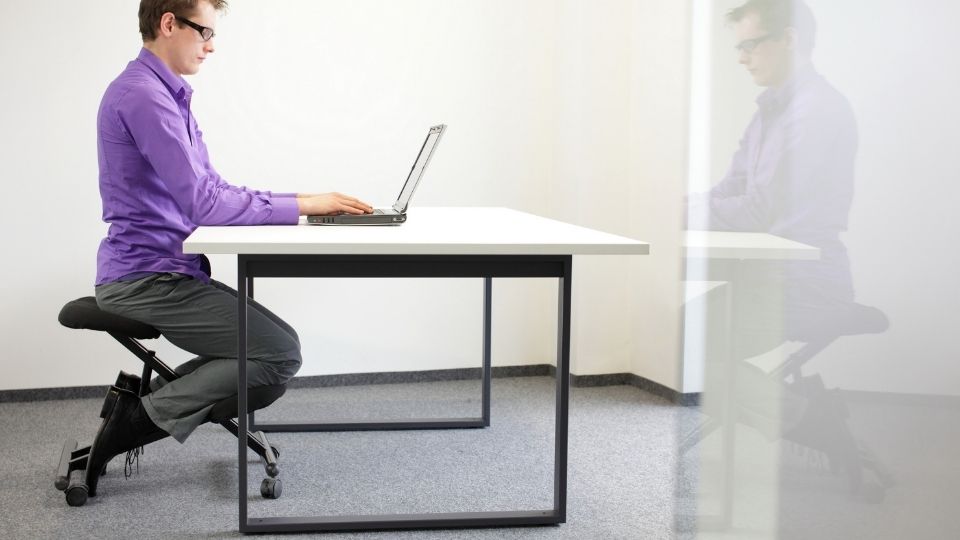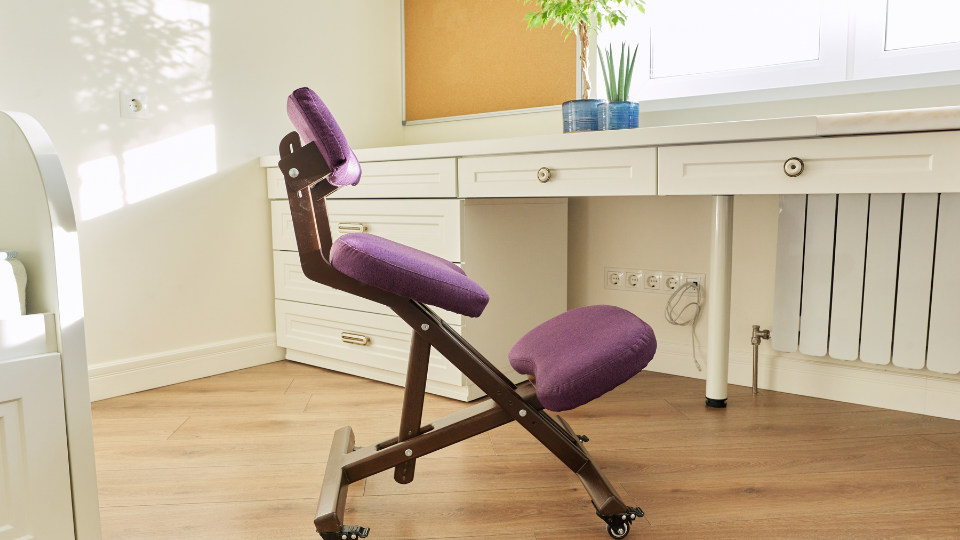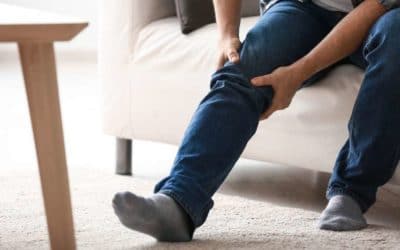There have been many talks lately about kneeling chairs and their potential benefits for your health. But what are they, exactly? And are they as good for you as people say? In this post, we’ll take a closer look at kneeling chairs and discuss the pros and cons of using them. By the end, you’ll be able to decide whether or not kneeling chairs suit you. So let’s get started!
As a general rule, kneeling chairs can help with your posture, relieve pressure on your low back, and reduce fatigue in the short term. The kneeling chair works by tilting the pelvis forward for better spinal alignment. As a result of reduced spinal rotation and knee pressure, they should not be used for more than 2 hours.
Let me help you figure out if a kneeling chair is a right choice for you. For over 30 years, I’ve been practicing chiropractic and have also trained as an ergonomist. I have a published book on posture, spoke on this subject on national tv, and have engineered several solutions to help people achieve better posture and comfort while sitting. In addition, I ran a successful Kickstarter campaign to fund the development of my latest project, a set of ergonomic seat cushions. With all of this experience and expertise, I can help you make an informed decision about whether or not a kneeling chair is right for you.
What Is the Benefit of a Kneeling Chair?
Kneeling chairs trended in the ’70s (even seen on The Brady Bunch!) and again have become increasingly popular in recent years, as more and more people are looking for ways to improve their posture and alleviate back pain. While there are many different types of ergonomic chairs on the market, kneeling chairs offer unique benefits. By tilting the pelvis forward and aligning the spine, kneeling chairs help to improve posture and reduce strain on the lower back. In addition, the open angle between the thigh and abdomen helps to increase blood flow and circulation to the area.
Kneeling chairs are often recommended for short-term task work by chiropractors, physiotherapists, and other health care professionals as a way to improve posture and reduce back pain.
All Day Comfort & Support
Do Kneeling Chairs Hurt Knees?
Some experts claim that kneeling chairs can lead to joint pain, particularly in the knees. This is because your leg movements are restricted when you are seated in a kneeling chair. This can put pressure on the shins, which can cause pain over time. Additionally, kneeling chairs can restrict circulation to the legs, which can be problematic for people who suffer from circulation issues. Finally, getting up and down from a kneeling chair can be difficult, particularly if you have any mobility issues.
Black Friday: 35% Off Today
Typical Delivery 1-3 Days
Are Kneeling Chairs Good for Your Spine?
Proponents of kneeling chairs say they help improve your posture by aligning your spine and pelvis. One study found that kneeling chairs set at 20 degrees (or more) inclination can maintain standing lumbar curvature. However, another study found that typical office chairs were judged to be more comfortable and desirable to sit on than the ‘kneeling chairs’ based on subjective data obtained from a questionnaire. Another small study found that reductions in ‘self-rated’ low back pain were observed. Another study found that scoliosis patients greatly improved comfortableness with prolonged sitting, and reduce low-back pain!
Additionally, experts argue that these kneeling chairs put less strain on your back than traditional chairs because they allow you to maintain a more upright position. However, again, not all experts agree that kneeling chairs are beneficial for your spine. Some of my patients have found that these chairs can increase the pressure on your lower back, neck, and shoulders.
I’ve written a complete hands-on review about the best sitting position for sciatica, and here is what I tested best with my sciatica patients.
Is It Healthier to Kneel or Sit?
Sitting in a chair for long periods can adversely affect your health. Kneeling chairs have been shown to reduce the risks associated with extended sitting. They also help improve the strength in your neck and back, improve blood circulation, reduce chronic pain in the arms and hands, and promote deeper breathing. If you are looking for an excellent short-term seating device, then I recommend kneeling chairs as a great way to improve your overall health and well-being.
All Day Comfort & Support
What Chairs Do Chiropractors Recommend?
When finding the perfect chair, (we) chiropractors tend to have very specific requirements. We look for chairs that can elevate, have armrests, offer seat translation with a forward tilt, and provide lumbar support. These features are all designed to help improve posture and prevent back pain. In addition, many of us chiropractors prefer chairs with a waterfall front edge, which helps reduce pressure on the thighs and promotes better circulation. Ultimately, the best chair for a chiropractor will help their patients stay comfortable and pain-free.
How Long Should You Sit In Kneeling Chair?
When first using a kneeling chair, I typically recommend that my patients start with short sessions of no more than fifteen minutes. This will help your body to adjust to the new position and reduce the risk of pain or discomfort. Once you become more comfortable with the chair, you can gradually increase your time in it. However, taking breaks every twenty minutes is vital to stretch your legs and avoid stiffness. Remember, the best posture is always a moving posture!
For most people, spending more than two hours in a kneeling chair at one time is not recommended. Prolonged use can restrict leg circulation and cause pain in the shins. In addition, getting up and down from a kneeling chair can be difficult for some people. Therefore, listening to your body and taking breaks when using this chair is crucial.
Black Friday: 35% Off Today
Typical Delivery 1-3 Days
What Is the Proper Way to Sit on a Kneeling Chair?
Here’s what I tell my patients: When sitting in a kneeling chair, it is vital to find the correct balance between comfort and support. The best way to do this is to start by sitting on the chair seat, then slowly move your legs and shins into a kneeling position. If you feel you are being pushed forward onto the shin cushions, try sitting further back on the seat. Once you have found a comfortable position, maintain a good posture and keep your spine straight. In addition, it is essential to take regular breaks from sitting in a kneeling chair to stretch your legs and avoid stiffness or soreness. By following these simple tips, you can ensure that you get the most out of your kneeling chair.
Are Kneeling Chairs Good for Sciatica?
I know that you won’t like this answer, but, it depends. The effectiveness of kneeling chairs for sciatica is a topic of debate. Kneeling chairs are designed to reduce pressure on the spine when compared to traditional chairs. They promote an upright posture by aligning the back, shoulders and hips which may help to prevent back problems, including sciatica. However, it is important to note that kneeling chairs should only be used for short-term sitting, less than 2 hours.
Is a Backless Chair Better for Posture?
As a general rule, sitting on a backless chair is suitable for your posture because it allows your hips to move more freely. This not only helps to release tightness and relieve pain, but it can also improve circulation and increase energy levels.
*This is my opinion as a chiropractor and seat designer.
When we sit in a traditional chair, our hips are confined to a small range of motion. This can lead to tightness in the hips and lower back and fatigue. The increased range of motion can also help improve focus and concentration. For all these reasons, I often recommend that backless chairs offer various benefits beyond improved posture.
How Should I Sit to Avoid Lower Back Pain?
Good posture is important for many reasons. It can help maintain overall health, reduce the risk of back pain, improve mental clarity, prevent headaches, increase confidence, and enhance overall appearance. By paying attention to posture and making conscious efforts to sit and stand in a proper alignment, it can lead to a healthier and happier lifestyle.
Most of us spend our entire lives struggling with poor posture. It might seem like it’s just for show, but banality can lead to many serious health problems, including back pain and respiratory difficulties! Luckily, you could take some simple steps to improve your physical positioning, reducing the risks associated with this issue.
If you are into super easy and inexpensive alternatives to office chairs, I wrote a fantastic article on how and why you should consider these options for back pain, and I encourage you to read it!
Try an Ergonomic Seat Cushion

Ergonomic Design
Many people may not be aware of the significance of having proper alignment and balance in the spine. Sitting for prolonged periods can lead to tension and pain in other parts of the body, but there are ways to improve posture and reduce discomfort.
I was surprised how similar cheap memory foam seat cushions were on Aliexpress from the listing on Amazon!
When sitting, it is important to maintain proper posture and alignment. One way to do this is by positioning the hips higher than the knees. This can help engage more muscle groups and reduce muscle strain, leading to a more comfortable and sustainable sitting experience. Additionally, this position can help align the spine and improve balance.
I explain the concept of an ergonomic seat cushion on a TV show HERE!
Try an Orthopedic Mattress
A bad night’s sleep can leave you groggy and irritable, but did you know that it can also negatively impact your health? One of the most important things you can do for your spine is to invest in an orthopedic mattress.
Investing in a supportive sleeping surface (orthopedic mattress) and focusing on proper sleep posture can be beneficial for maintaining spinal alignment and reducing the risk of discomfort. Taking steps to ensure proper alignment while sleeping can also help prevent chronic health problems associated with poor posture. It’s important to note that it’s not only the mattress but also the person’s posture and sleeping positions that play a role in maintaining spinal alignment during sleep.
Are Stools Good for Your Back?
In my opinion, stools are an excellent option for those looking for an ergonomic solution. Stools allow you to get your feet under your body and your spine lifted straight, giving you a healthy, alert posture that makes it easy to focus on your work. In addition, stools provide the ability to adjust the height of your seat, so you can find the perfect position for your body type. And finally, stools are relatively affordable, making them an excellent option for those on a budget. So if you’re looking for an ergonomic solution that meets all of these criteria, a stool may be the perfect option.
Final Words
Kneeling chairs are designed to promote good posture and reduce pressure on the lower back. It may be a good option for those looking for a short-term alternative to traditional seating. However, it is important to note that due to a lack of armrests and rotational challenges, it should not be used for too long to avoid any potential negative effects. Have you had any experience with using a kneeling chair? Share your thoughts on it.
Sources:
- Bettany-Saltikov, J., Warren, J. and Jobson, M., 2008. Ergonomically designed kneeling chairs are they worth it?: Comparison of sagittal lumbar curvature in two different seating. Stud Health Technol Inform, 140, pp.103-106.
- Best, C.B.D. and Back, H., Kneeling Chairs.
- Annetts, S., Coales, P., Colville, R., Mistry, D., Moles, K., Thomas, B. and Van Deursen, R., 2012. A pilot investigation into the effects of different office chairs on spinal angles. European spine journal, 21(2), pp.165-170.
- Vaucher, M., Isner-Horobeti, M.E., Demattei, C., Alonso, S., Hérisson, C., Kouyoumdjian, P., van Dieën, J.H. and Dupeyron, A., 2015. Effect of a kneeling chair on lumbar curvature in patients with low back pain and healthy controls: A pilot study. Annals of Physical and Rehabilitation Medicine, 58(3), pp.151-156.
- Bridger, R.S., Kloote, C., Rowlands, B. and Fourie, G., 2000, July. Palliative Interventions for Sedentary Low Back Pain: The Physiotherapy Ball, the Kneeling Chair and Conventional Ergonomics Compared. In Proceedings of the Human Factors and Ergonomics Society Annual Meeting (Vol. 44, No. 29, pp. 5-87). Sage CA: Los Angeles, CA: SAGE Publications.
- Wang, F. and Feng, X., 2011. Ergonomically Designed Kneeling Chair Influence on Adolescent Idiopathic Scoliosis. In Advanced Materials Research (Vol. 328, pp. 726-729). Trans Tech Publications Ltd.








